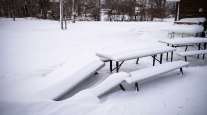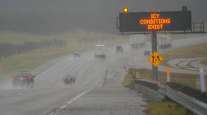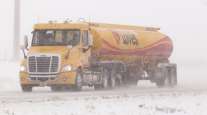Rail Lines Cut in Flooded Midwest, Which Faces More Rain

The Great Plains and Midwest, struggling with flooding that inundated roads and farms and pushed rivers to record heights, is set to get more rain ahead, with light showers forecast over the next few days and a heavier downpour next week.
At least 17 high-water records have been set across Nebraska, where 660 people are in evacuation shelters and the National Guard and State Patrol have had to rescue more than 175 people, the Nebraska Emergency Management Agency said in a statement. Vice President Mike Pence tweeted March 19 that he’s heading to Nebraska to survey the damage.
Farmers who have been struggling financially from the U.S. trade war with China are also bearing the brunt of the insistent rain and flooding, with many in the South falling behind on planting corn, soybeans, cotton and other crops.
“Some of these places need an extended period of dry weather to get fieldwork started,” said Dan Hicks, a meteorologist at Freese-Notis Weather in Des Moines, Iowa. “But I don’t see an extended dry spell.”
Devastating flooding hits already struggling Midwest farmers https://t.co/4e7121WUpm pic.twitter.com/T32A0bfWey — CBS News (@CBSNews) March 19, 2019
Flooding also cut a number of BNSF railway lines, with the railroad anticipating that tracks on its Hannibal and River subdivisions along the Mississippi River will possibly be out of service through March 20, according to its website. The Union Pacific railroad has also reported a number of lines out.
A weak rain system is expected to move through the region over the next five days, according to Don Keeney, a meteorologist with Radiant Solutions in Gaithersburg, Md. “But amounts will be really light,” Keeney said by telephone March 19. “It is not going to add to the flooding.”
Next week, though, heavier rain could sweep across the central U.S. from southern Nebraska into the Mississippi Delta region and Ohio Valley, adding to troubles there, Keeney said.
The rains are disrupting ethanol supply, sending prices of the corn-made biofuel to a seven-month high. Meanwhile, rising waters flooded parts of Offutt Air Force Base in Nebraska and pushed the Missouri within a foot of closing the Cooper Nuclear Station in Brownville.
“It was miles wide,” said Bob Henson, a meteorologist with the Weather Underground who was in Nebraska City March 17. “It was the scope of the river’s breadth that really amazed me.”
The Mississippi and Ohio Rivers have been spilling their banks for weeks, slowing river traffic. Last week’s winter storm across the Great Plains has pushed the Missouri River to record levels in many places.
Record river flooding has plagued six states in the Plains and Midwest, and 40 locations have topped new record river levels as rivers continue to rise: https://t.co/XztO9t9jXs pic.twitter.com/WoDNZPf34y — The Weather Channel (@weatherchannel) March 17, 2019
In February, the U.S. Army Corps of Engineers had to open the Bonnet Carre Spillway 28 miles upstream on the Mississippi from New Orleans to take flooding pressure off the city. The spillway, finished in 1931, has only been opened 13 times, and this is the first time it has been used in back-to-back years, said Matt Roe, spokesman for the Army Corps of Engineers New Orleans District.
The flood woes extend north as well. The mayor of Fargo, N.D., declared an emergency and ordered 1 million sandbags to barricade the city from the Red River, which is expected to flood in coming weeks.
The river, which forms the border between North Dakota and Minnesota, flows north into Manitoba, where provincial officials predict it will now rise higher than an epic 2009 flood, when waters crested in Winnipeg at 22½ feet.
“It was the wettest winter for the U.S. on record,” Henson said. “In this case, more than 40 of the 48 contiguous states were above average all the way from California to Maine.”
80-year-old woman trapped in home among 3 dead from historic flooding in Midwest. https://t.co/GJsmPW8xrs pic.twitter.com/szZcBU54rT — ABC News (@ABC) March 19, 2019
The soils saturated in the fall, froze and then became snow covered, he said. The melting snow and rains now have no place to go.
Even away from the areas where rivers have broken their banks, it will take a while to dry out the land, Hicks said. In many cases, because rivers and streams are swollen, there is no place for water to go every time it rains.
“Exceptionally wet” conditions from the Mississippi River Delta in Arkansas to North Carolina will slow fieldwork and plantings of corn and soybeans this week, according to Global Weather Monitoring.
Rain predicted later in the week will further hamper plantings in the South, where farmers are typically among the first to plant crops in the spring. Rains and melting snow also caused severe flooding in the Plains region, cutting off access to cattle and forcing ethanol plants in Nebraska to shut down.




